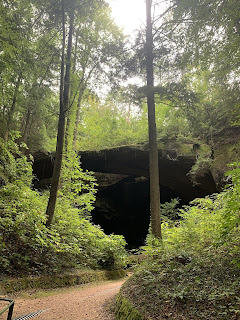For this week’s blog I am taking you out of state to
the city of Columbus, Georgia. This is a city that I interned in this past
summer at WRBL News 3! It was a very neat experience and I loved being a part
of this town for two months. I hope that you can find the history of the town
neat enough to want to visit too!
The area of Columbus, Georgia was originally owned and
inhabited by the Creek Indians. In 1828, the area was founded and officially
named Columbus in an act passed by Georgia Legislature. The city was actually named
after Christopher Columbus! A man named Dr. Edwin L. DeGraffenreid drew a plan
for the town and put it on a bluff overlooking the river. In 1836, the last
remaining Creek Indians were sadly forcibly removed by the federal government for
the European-Americans coming into the town.
The city took advantage of the river running beside it
and used it to ship cotton from the plantations down to New Orleans. The crop
would then be shipped to Liverpool, England. In the 1850s, the railroad system
came to the city, helping it grow even more. Columbus also brought textile
mills to the area and built them along the river. Columbus became an important
industrial center of the South by 1860 and earned the nickname “Lowell of the
South.” Lowell was an important textile mill town located in Massachusetts.


When the Civil War started, Columbus became one of the
most important places of industry to the Confederacy. They were second to
Richmond, Virginia. Columbus manufactured materials for Confederate uniforms,
cannons, machinery, firearms, swords, bayonets, and ammunition. Columbus also
had a shipyard for the Confederate Navy. On April 16, 1865, the Battle of
Columbus took place and many of the industrial buildings were burned down. This
battle is considered the “Last Land Battle in the War from 1861 to 1865.”
In the spring of 1866, a group in Columbus called the
Ladies Memorial Association signed to set aside one day to honor those who died
for the Confederacy. Ladies from all of the southern states were invited to come
to Columbus to celebrate. A lady named Elizabeth Rutherford Ellis chose April
26, 1866 as the first official day to celebrate Confederate Memorial Day. Quite
a few cities in the South have tried to say they started the holiday, but it has
be proven to have been Columbus.
The Springer Opera House was built in 1871 and was
named the official State Theater of Georgia by former President Jimmy Carter on
its 100th anniversary. In its hay day Oscar Wilde came to the theater.
In October of 1909, Columbus mayor Lucius Chappell brought
the then named Camp Benning to the area to train soldiers. In 1922, it was
renamed to Fort Benning after the Confederate General Henry L. Benning who was
a native of Columbus.
As the city continued to grow Columbus College was founded
in 1958. It started out as a two- year university but grew into what is today
Columbus State University. It was renamed in 1996. In the 1960s to 1980s, the
Columbus area started seeing a decline. The class groups started to show a divide
and prostitution became prevalent. But many improvements began to be made.
Neighborhoods were fixed up, historic buildings and areas were redone, large residential
neighborhoods were built for soldiers after the Vietnam War, and new projects were
done. These projects included a softball complex which hosted 1996 Olympic
softball competition, the Chattahoochee Riverwalk, the National Civil War Naval
Museum, the Coco-Cola Space Science Center, expansion of Columbus Museum, fixed
roads, and a new bridge connecting Columbus to Phenix City, Alabama.



Columbus is a beautiful city with quite a few cites to
see. Some more places I recommend visiting are the National Infantry Museum, whitewater
rafting (Columbus has the longest urban venue in the world), Broadway Street,
the Riverwalk, Columbus Art Museum,
and there is so much more to find! It is an awesome city that I hope you will
have the chance to visit one day too!
I had the chance to interview two people who live in
the area. One Smith Station, Alabama resident Yolanda Allen and the other is
Columbus resident Kate Lopez. Here are the questions and answers:
How long have you lived here/in the area?
Yolanda Allen: “I moved here 13 years ago.
My mom and dad wanted to move closer to home since dad retired from the army.”
Kate Lopez: “Going on seven months.”
What is your favorite part of Columbus?
YA: “Downtown Columbus is my favorite part
of the area. There’s a lot of food spots and entertainment. Plus, the Riverwalk
is also there. Which you can walk, fish, and go white water rafting at.”
KL: “Location wise, downtown for sure.”
What is your favorite part of the history
of Columbus?
YA: “The Springer Opera House is one of my
favorite things about the history of Columbus. It has been there since the
1800s and it still has live performances inside the building.’
KL: “It used to be a big port city back in
the 1800s. It was used to transport supplies during the Civil War. It’s my favorite
because they still have the old buildings from back then downtown and it’s nice
to walk there and see them.”
Would you recommend Columbus as a place to
live for people? Why/why not?
YA: “I would recommend Columbus as a place
to live. I honestly don’t think it’s a bad place to live. There is a lot of
stuff you can do in Columbus.”
KL: “Yes, it’s pretty. There are a lot of
places to go out to and do with family or even just yourself. There are a lot
of parks here too if that’s your thing. Many job opportunities and schools. It’s
a busy city most of the time but it’s also a quiet and chill city too.”






































